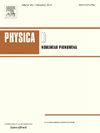Nonlinear q-voter model involving nonconformity on networks
IF 2.7
3区 数学
Q1 MATHEMATICS, APPLIED
引用次数: 0
Abstract
The order–disorder phase transition is a fascinating phenomenon in opinion dynamics models within sociophysics. This transition emerges due to noise parameters, interpreted as social behaviors such as anticonformity and independence (nonconformity) in a social context. In this study, we examine the impact of nonconformist behaviors on the macroscopic states of the system. Both anticonformity and independence are parameterized by a probability , with the model implemented on a complete graph and a scale-free network. Furthermore, we introduce a skepticism parameter , which quantifies a voter’s propensity for nonconformity. Our analytical and simulation results reveal that the model exhibits continuous and discontinuous phase transitions for nonzero values of at specific values of . We estimate the critical exponents using finite-size scaling analysis to classify the model’s universality. The findings suggest that the model on the complete graph and the scale-free network share the same universality class as the mean-field Ising model. Additionally, we explore the scaling behavior associated with variations in and assess the influence of and on the system’s opinion dynamics.
求助全文
约1分钟内获得全文
求助全文
来源期刊

Physica D: Nonlinear Phenomena
物理-物理:数学物理
CiteScore
7.30
自引率
7.50%
发文量
213
审稿时长
65 days
期刊介绍:
Physica D (Nonlinear Phenomena) publishes research and review articles reporting on experimental and theoretical works, techniques and ideas that advance the understanding of nonlinear phenomena. Topics encompass wave motion in physical, chemical and biological systems; physical or biological phenomena governed by nonlinear field equations, including hydrodynamics and turbulence; pattern formation and cooperative phenomena; instability, bifurcations, chaos, and space-time disorder; integrable/Hamiltonian systems; asymptotic analysis and, more generally, mathematical methods for nonlinear systems.
 求助内容:
求助内容: 应助结果提醒方式:
应助结果提醒方式:


